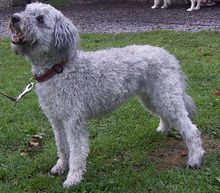| Pumi | |||||||||||||||||||||||||||||
|---|---|---|---|---|---|---|---|---|---|---|---|---|---|---|---|---|---|---|---|---|---|---|---|---|---|---|---|---|---|
 | |||||||||||||||||||||||||||||
| Other names | Hungarian Pumi | ||||||||||||||||||||||||||||
| Origin | Hungary | ||||||||||||||||||||||||||||
| |||||||||||||||||||||||||||||
| |||||||||||||||||||||||||||||
| Dog (domestic dog) | |||||||||||||||||||||||||||||
The Pumi (in Hungarian, the plural form is pumik) is a medium-small breed of sheep dog from Hungary. They are capable herding dogs, able to gather and work close to farm stock, particularly sheep, to keep them under control. Pumik have an extended, tapered muzzle with prominent ears, and a tail curled over their back, and are sometimes described as having a whimsical expression. The double coat (black, white, grey, or fawn) has a mix of wavy and curly hair.
The Pumi is considered to have arisen from the cross-breeding of Hungarian Puli with French and German herding dogs from the 17th century onwards. The international breed standard was approved in 1935. The Pumi became an officially recognised breed in the US in 2011 and in the UK in 2015. There are over 2,000 Pumis registered in Hungary, with notable populations in Finland and Sweden and small but growing numbers of registrations in the US, UK and Germany.
Some refer to the Pumi as the "Hungarian herding terrier" because it has some terrier-like attributes such as quick movement, alert temperament, and a quadratic, lean and muscular body type.
- ^ a b c d "Breed Standard: Hungarian Pumi". www.thekennelclub.org.uk. The Kennel Club (UK). June 2015. Retrieved 18 December 2017.[permanent dead link]
- ^ Cite error: The named reference
Pumanwas invoked but never defined (see the help page). - ^ Anderson, Alyssa. "What To Know About a Pumi". www.webmd.com. WebMD. Retrieved 25 February 2024.
- ^ "Breed Traits & Characteristics". American Kennel Club.